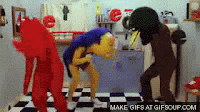By then I felt a bit disheartened but I kept it in the corner of my mind. After some time it occurred to me that it didn't matter whether I featured my dolls or not, my interest for them did not just stop at their appearance and customization possibilities, but also the ingenuity of their stringing mechanism, the different joint types that people invented for better posing, the process of sculpting them in clay to later cast them in resin...
I started thinking of a way to mix one of these BJD traits to animation. My initial idea was to focus on customization and perception. I wanted to have different students have a go at dressing one of my dolls up and maybe give instructions to them like " this look has to show loneliness" or "this look must portray anger". But another idea was sprouting in my head. A part of me wanted to pay homage to what's happening inside of BJDs, the strings and hooks, the tension and the joints. This is something that only hobbyists know about and appreciate. Companies with the best posing abilities get famous for that! This is something so important and constantly improving in the hobby!
But how to apply this to animation? In theory, it's simple: rigging! But in practice, not so easy. How would I rig live action. I had to think about it for a long time. I had to strip the idea to its simplest shape. Strings. Hooks. Anchors. These are my skeleton. But what do I rig with that? And so I thought, why not a digital puppet? That's when it all started to fit in. My rig would be recorded on camera and my "doll" or character would be digital.
The last step was to determine how my rig would work and how I would present it. I picked up what I had available at home and started making a grid with a cork board and pins...












